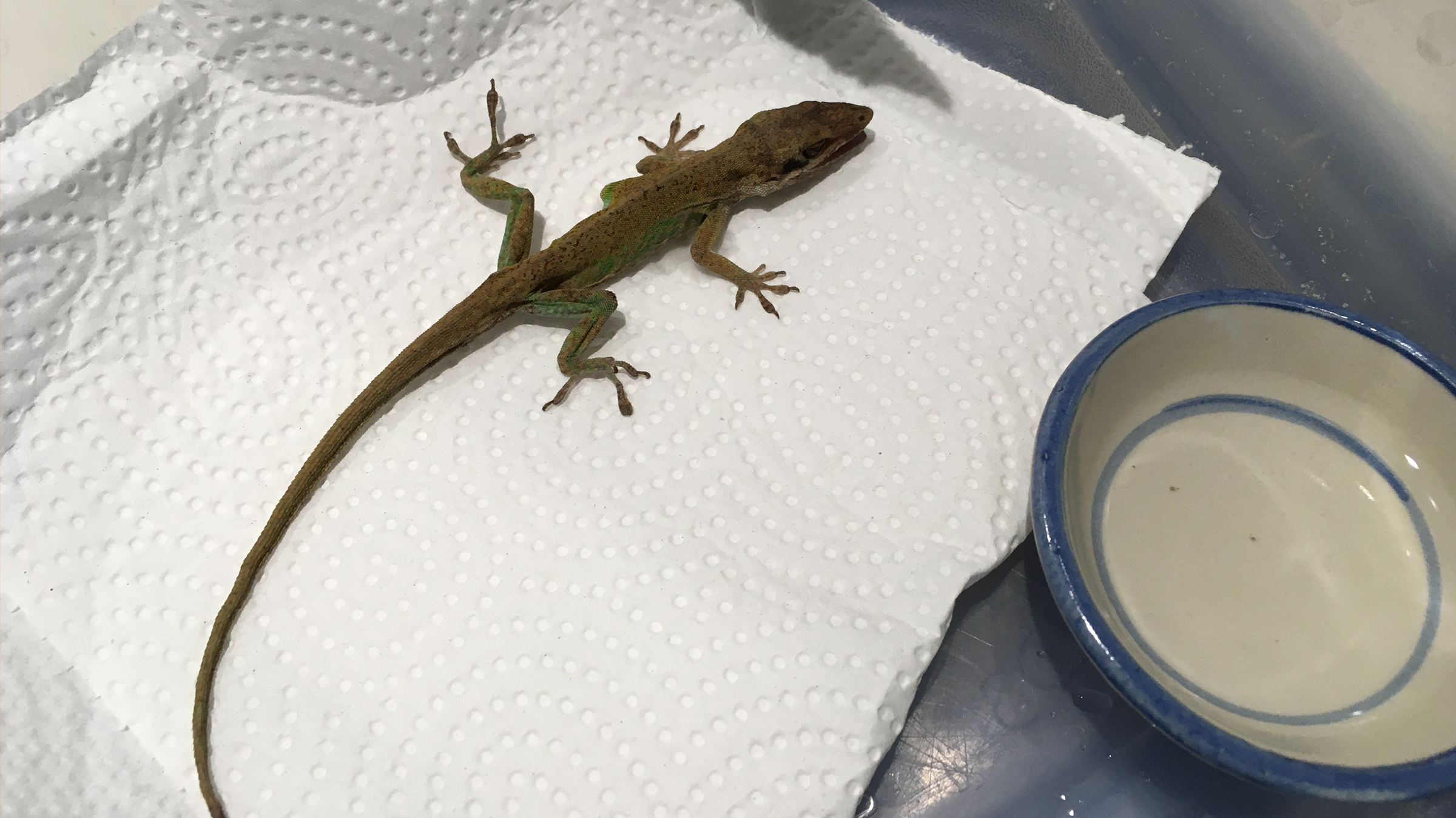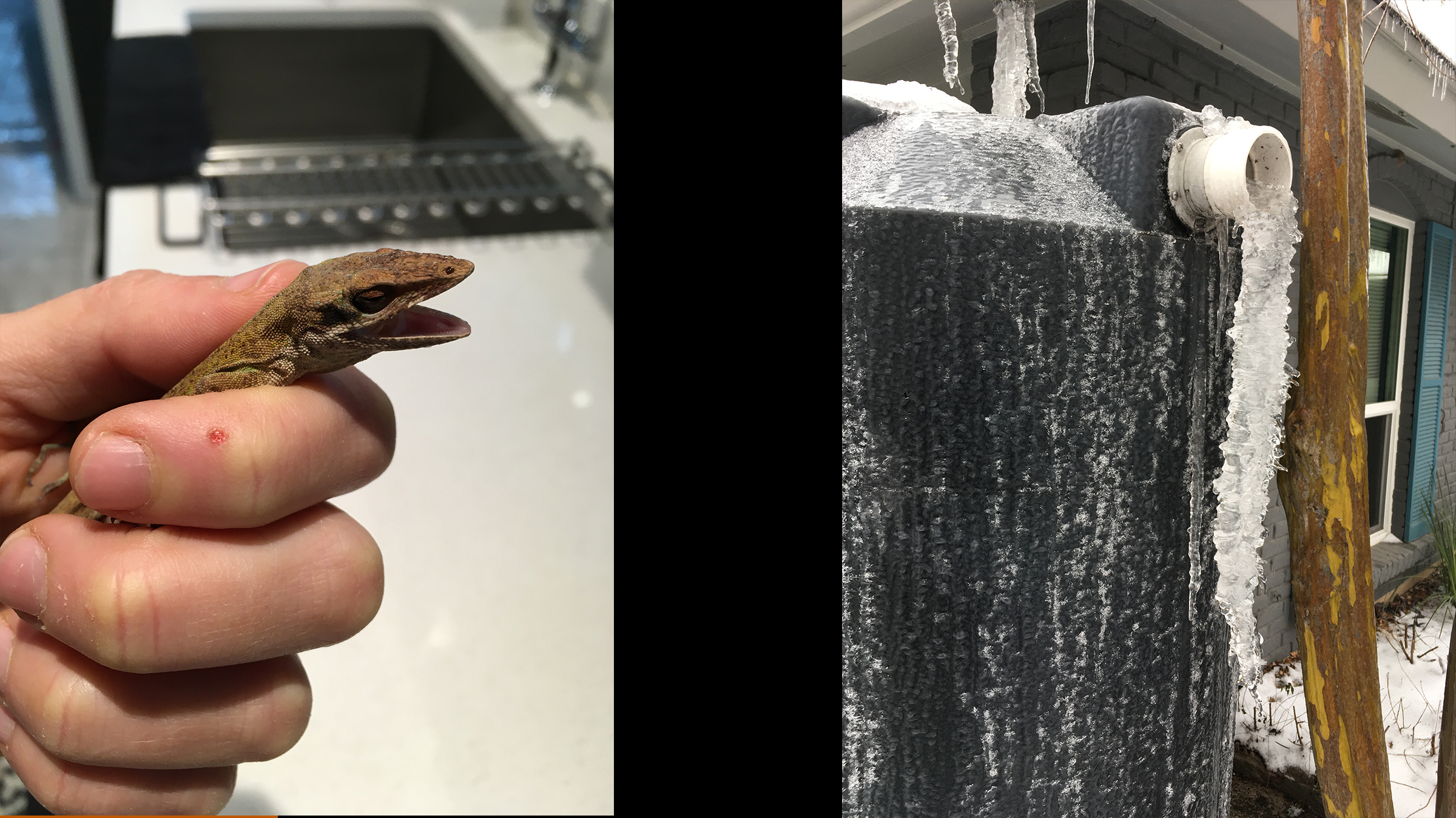
With the weather finally cooling, I think about the upcoming winter. Usually, it’s the most beloved Austin season for me as I can go outside comfortably without the aid of mosquito repellent, for about a month anyway.
This year however, I wonder about the next season with some trepidation. Most of us here in Austin right now remember winter storm Uri and the havoc it played in our lives last year. It’s hard to forget a storm like that. While I got away relatively unscathed, (Iost some trees and plants and had no running water for three days), many others dealt with exploding water heaters, indoor floods, days of power outages in addition to no water or heat.
It was during the early part of the storm, however, that I had an interesting encounter with a green anole.
It occurred right after a day of preparing for lows in the single digits. I had moved all 50 of my outdoor potted plants into the garage, wrapped my outdoor faucets with little tents heated with incandescent bulbs, and pulled out some tattered long johns, the only true winter clothing I own. I also went to check on my furnace and water heater. They are both located in the middle of my house in a closet. With the exception of the vent ducts, this space is completely open to the attic and all the temperature fluctuations that occur there.
I opened the doors to this closet, trying to think of ways to keep the area warmer, when I noticed something sitting at the base of the furnace. It was a male green anole, but in this case, it was brown. I had no idea how he had found his way into my attic, wandered in near darkness over several inches of dusty old insulation, to find the furnace in the heart of my house. This was not an easy feat and I wondered if he had a sense of what terrible cold was coming.

Left: A dehydrated “Lizard Friend.” Right: Frozen water from rain barrel.
I picked up this lethargic creature and it offered no resistance. I carried him from the dark closet and into my much brighter kitchen. There I found a big Tupperware container and placed him inside. He looked dehydrated, bony, and was most likely hungry. I wasted no time, found a cotton ball and soaked it in water. I gently gripped the anole (see picture above) and he opened his jaws, most likely in whatever energy he had left at self-defense. This allowed me to put the drenched cotton ball there.
Before I talk about my next few days with this tiny lizard, let’s go a bit into what they are. The green anole (Anolis carolinensis) lives not in dark cold attics like mine but primarily in trees and shrubs. They are very common in urban areas like here in Austin. But I will say I had not seen any in my own yard until I replaced the lawn with native plants. It tooks a few years for them to find it, but now a day doesn’t go by when I don’t see several.
The males are quite a bit larger than the females but are easy to differentiate when adults. Mature females have a faint line that runs along their dorsal surface. Mature males have “dewlaps” which are little flaps of skin on their throats, pinkish in color, which they flare during courtship as well as when defending territories. Male anoles also do what to us look like little pushups while showing off their dewlaps. They do this to attract mates as well as to determine competitive status with other males.
Female green anoles can store sperm after mating, which makes delayed fertilization possible. They prefer moist soil for laying their eggs. The gestation period is usually between five to seven weeks.
When green anoles hatch they resemble adults but without the sexual differences. They are quite small, about 23 mm in length. They grow at a steady rate into adulthood without parental investment.
The average lifespan is about 5 years, but with adequate food resources, those in the wild can live several years more.
One of the most striking features of the green anoles, outside their courtship displays, is their color change. In just a matter of minutes, green anoles can go from almost neon green to deep brown. They change color due to a variety of reasons, such as stress or to send a social signal. They don’t change color due to whatever they are sitting on, contrary to common belief.
Now, back to my own green anole visitor. After providing some hydration, I put him back in the Tupperware with a crack for air. He didn’t try to escape. As I have three very curious cats, I kept him in a closed bedroom. Weather forecasts predicted five nights of temps well below freezing, with daytime highs just under freezing. I didn’t want to put the anole into this kind of brutal environment, so the Tupperware home it was.
Next problem. Judging by the visibility of his bones, this little guy needed some nourishment. Where to find bugs when there were inches of snow outside? I found a few dead fungus gnats and fruit flies on the window sill and tried to make something palatable for my new housemate, but it certainly wasn’t much. Luck would have it that I found a silver fish scurrying over the floor. I caught it and fed it to the green anole.
Life like this would continue for the next five days, with me providing cotton ball water, and hoping I’d find another insect. He seemed to be gaining strength as he showed more displeasure at being cooped up in a Tupperware container, and who could blame him?
Finally, when Austin broke through the freezing spell, I could release him. In between collecting buckets of melting snow (I had no running water), I took him outside and, as you’ll see in the video down below, let him go. He took off with about as much vigor as one can expect from being stuck in a Tupperware container for five days. But his limbs looked plumper, and he had more energy. He took off behind a winter-damaged salvia and I wished him well.
I thought that would be the last of my little friend, but strangely enough, he never went away. As the weather warmed, I noticed a particular green anole had set up his territory right outside my kitchen window. It’s my favorite window in my house, and I have planted enough native shrubs to provide ample habitat for whatever creature finds safety or nourishment in them. In this case, the green anole that called this area home was the one I had saved from my furnace closet.
But wait, you might be asking, how could I know this? Don’t all males look alike? Sure they do, if you only see one once or twice. But since I had spent so much time with my particular lizard, giving him water and dead gnats, I had time to notice his physical peculiarities. The most noteworthy was his oddly-shaped rib cage on his left side, as if he’d been injured in a territorial dispute or during an escape from a predator.
This green anole outside my kitchen window showed the same marking, and since the other males I had seen were not nearly as unique looking, I could only assume it was my lizard friend. In fact, I named him “Lizard Friend,” and was delighted each time I spotted him basking on the fence, chasing off some competitor, or trying to woo a female. With courtship season in full swing this summer, I also got to notice how his dewlap was damaged, giving him more like half a dewlap. I laughed to think about how Lizard Friend was in reality, just some old war-tattered green anole strutting his stuff around the yard. He was a welcome sight during year two of the pandemic, when my house was feeling more like a prison.
Quite often, there is contention when people write about their connections to animals and use language that makes them seem like us. But it’s easy to ascribe our human emotions and actions on to other living beings when we make contact with them. I think about the documentary My Octopus Teacher as a recent example, and the late Ndakasi, an orphaned mountain gorilla that had “photobombed” a park ranger’s selfie.
For me, connecting with the creatures that surround me means I observe them, think about them, respect them, and try to protect them, whether that be in in the lush diverse yard I’ve created for them, or during historic winter storms. It’s natural and healthy to connect to wildlife, and I would argue, might be one way to save our biodiversity. It will take all of us to slow the damage, and to paraphrase the Biodiversity Center’s Director, David Hillis: you can’t protect what you don’t love.
I haven’t seen Lizard Friend in a while. Perhaps with mating season at its end, he’s not on fence posts, showing off to the ladies. Or perhaps he’s lost his territory to another male. Or perhaps he has died. Wherever he is, I take comfort knowing he probably has many offspring in my yard, and that one Lizard Friend Junior might just set up home outside my kitchen window and continue to be a source of endless fascination.
SOURCES
Crawford, Chelsea “Anolis carolinensis” (Green anole) Animal Diversity Web (https://animaldiversity.org/accounts/Anolis_carolinensis/)
Green Anole (Anolis carolinensis). Texas Parks and Wildlife. (accessed online: https://tpwd.texas.gov/huntwild/wild/species/anole/)
Green Anole (Anolis carolinensis). Savannah River Ecology Laboratory, University of Georgia. (accessed online: https://srelherp.uga.edu/lizards/anocar.htm)



